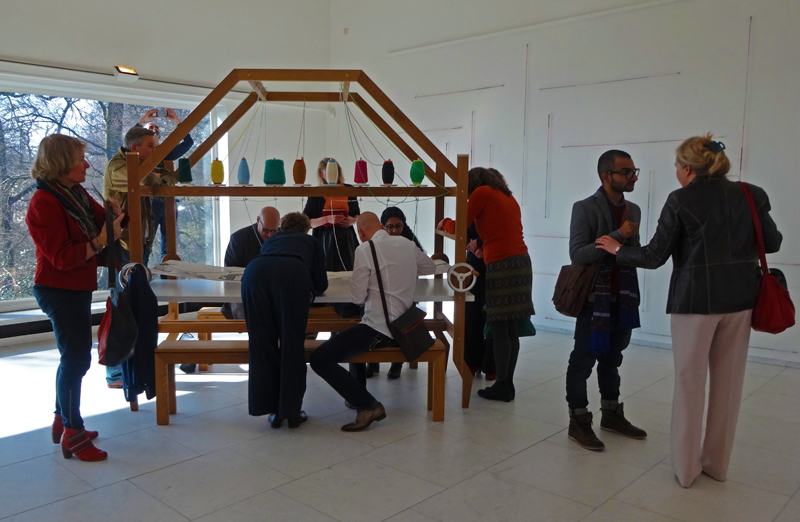
Exhibition of 19 March to 17 August 2014 at the Museum Arnhem. This was the fourth exhibition of “fine” art and textiles, we could visit in the past few months , first Mönchengladbach , then Wolfsburg , Bielefeld and finally in Arnhem. Unfortunately, this exhibition was like a second infusion , without highlights and excitement. The “big names” of this exhibition, Chiharu Shiota and Kimsooja were to be found already in Wolfsburg ( Shiota with a much more impressive work). The special feature of this exhibition in Arnhem was the geographically widespread participation , because, apart from seven Dutch artists, the 26 participating artists came from all over the world . With only a few exceptions, such as the silk sculpture by Lian Tianmiao and minature embroideries by Berend Strik , the work was miserably crafted . The carpets of Faig Ahmed from Azerbaidzhan were very skillfully woven and knotted, but not by the artist, who had limited himself to alienation and cutting up.
Unfortunately, historical examples of textile art were missing here, whereas in the German exhibitions they had made a good point of contrast .
What was it that the artist shown had in common? Besides a nearly ubiquitous disregard for textiles , it seemed to me that all were quite deliberately after making a name on the international art market, or were about to create such a name. Except for the Chinese Lin Tianmiao, none of them was there, who would have dared to call him/herself a textile artist. Regarding Lin Tianmiao I had heard this term only at other exhibitions.
The curator Miriam Westen had been motivated to organise this exhibition,inter alia, by the work ” Tread Routes” of Kimsooja . She said: “So much attention for textile design has given me something to think. Although textile is not normally considered a full-fledged art medium, it still has great importance, which is valued more in other parts of the world but, unfortunately is disappearing there too.”
Asked about the inexact descriptions of textile materials and techniques , the curator said: “But it ‘s not just about textiles, it’s about art, using textile to form metaphors and to refer to community and social issues.” She referred to the exhibition “Textiles – Art and the Social Fabric” which was held from 11 September 2009 to 3 January 2010 at the Museum of Contemporary Art in Antwerp.
Unfortunately, the Arnhem exhibition is another in the series of exhibitions, violating textile in the name of art .
I am aware that many textile artists put great hopes in this new attention for textiles . They hope that finally and rightly the big museums will open their doors for textile artists . Unfortunately , through the new fashion of “creating works of art using textiles” this hope is not met, as the art scene has been able to maintain the watertight separation between ` Art ` and Textile Art . Only in individual cases, already dead or older textile artists , as right now Sheila Hicks, are courted by the art market In her case her gallery did not mention any “textile” adjective. Sheila Hicks was the younger of the big names from the departure time of textile art in Lausanne. Textile artists from that time together with those from the Bauhaus have now reached museum dignity, both with applied , and with textile art.
[smoothslider id=’3′]